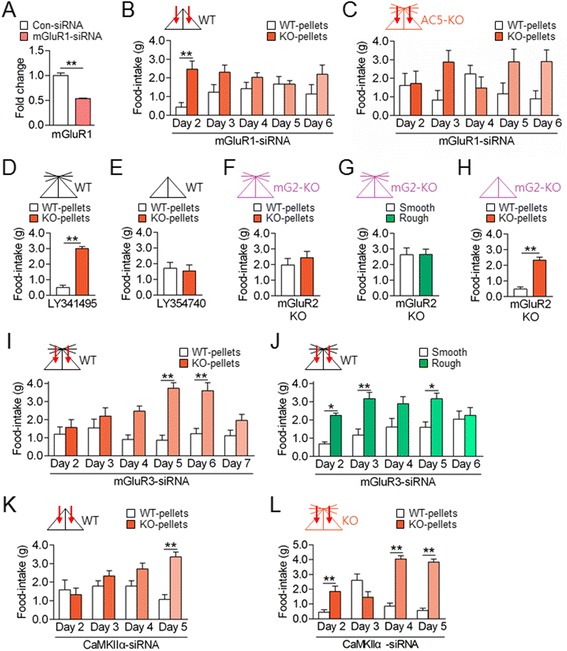Figure 7.

The mGluR1 and mGluR3 signaling systems in the dorsal striatum antagonistically regulated behavioral preferences for AC5 KO food pellets. (A-C) siRNA-mediated knockdown of mGluR1 in the dorsal striatum (A) suppressed behavioral preferences for AC5 KO pellets over WT pellets in WT mice with cut whiskers (B) and in AC5 KO mice (C). Two-way repeated measures ANOVA, Holm-Sidak test: for mGluR1-siRNA (B), food [F (1, 12) = 11.15, p = 0.0059], no time effect and no interaction; for mGluR1-siRNA (C), no food and no time effects, but food × time interaction [F (4, 48) = 3.007, p = 0.0271]. (D, E) Administration of the mGluR2/3 antagonist LY341495 in WT mice induced behavioral preferences for KO food over WT food (D). The mGluR2/3 agonist LY354740 in WT mice with cut whiskers blocked behavioral preferences for AC5 KO pellets (E). (F-H) mGluR2 KO mice did not exhibit behavioral preferences for KO pellets over WT pellets (F) and rough food pellets (G). Whisker trimming in mGluR2 KO induced behavioral preferences for KO pellets over WT pellets (H). (I, J) Injection of mGluR3-siRNA in the dorsal striatum in WT mice induced behavioral preferences for KO pellets over WT pellets (I) and for rough pellets over smooth pellets (J). Two-way repeated measures ANOVA, for mGluR3-siRNA (I), significant food and time effects, and significant interaction; for mGluR3-siRNA (J), significant food effect, but no time effect and no interaction. (K, L) Injection of CaMKIIα-siRNA into the dorsal striatum suppressed behavioral preferences for KO pellets over WT pellets in both WT mice with cut whiskers (K) and in AC5 KO mice (L). Two-way repeated measures ANOVA for both (K, L), significant food and time effects and significant interaction. Data are presented as the mean ± SEM (n = 7-9). * and ** denote the difference between indicated groups at p <0.05 and p <0.01.
